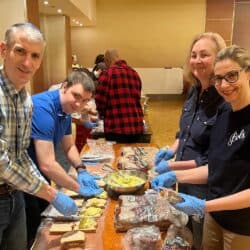“Viewpoint” offers an opportunity for discussion of topics and opinions of particular interest to the philanthropic sector.
This article was developed from a presentation to the 2001 Annual Conference of the Trillium Foundation.
Achieving sustainability is the “Holy Grail” for many grantmakers. Some funders choose to focus on the power of public policy as the tool to achieve sustainability; others focus on research and public education to ensure knowledgeable responses to social issues. But for those who toil in the trenches with local groups and civil society organizations that provide much needed services, achieving sustainability poses special challenges, as many grantmakers neither possess the resources nor the staying power to “stick” with a program or organization long enough to allow it to fulfil its promise. Instead, funders take refuge in putting the onus for achieving sustainability on community groups who are, by and large, so anxious to receive funding approval that they, in turn, resort to repeating promises that funders want to hear but which are in no measure achievable. At best, this kind of false sustainability is a naive dream. At worst, such notions pander only to our vanity as funders.
Perhaps we need to think about sustainability as something other than the ability of a system, or a program, or an initiative, to continue functioning for the indefinite future without being forced into decline. I would like to draw upon the metaphors of ecology to justify my personal conclusion that total sustainability is neither possible nor desirable. All systems have a natural curve of growth and decline. Out of growth and decline arise new ideas and innovations. Julie White, a former executive director of the Trillium Foundation, compared the natural decline of systems to the ecological renewal resulting from a forest fire. “As with forests, sometimes the underbrush needs to be burned out to provide for new growth.”1
This does not mean that we should give up on the idea of sustainability. Rather, we should look for it in a different manner and in different places. The truth about sustainability may well lie between the naive dream and the vanity mirror, and I believe that that truth is called “capacity”. Like learning, capacity never dies; it expresses and reinvents itself in different ways at different times.
An investment in capacity enables a community, a leader, or an organization to develop their potential in different ways, allows them to evolve and mature, and permits them to respond to the changing context around them. If, as funders, we are able to achieve these goals, then we have come close to grasping the golden ring of success.
The Maytree Foundation’s focus, the reduction of poverty, has provided fertile learning ground for us in capacity building. As a private foundation interested in making positive change, it would be easy for us to fall under the spell of a seductive idea or a charismatic leader. We have therefore schooled ourselves to look behind the glamour of an idea or individual and examine the workings of the organizations behind them. We know that the best leaders will falter when their organizational support is weak. We understand that it is important and strategically essential to develop the capacity, not only of leaders, but also of their communities and organizations so that they are in a better position to execute their catalytic ideas and carry out their missions.
Over the last three years, we have directed our resources to capacity-building in a particular community of organizations serving immigrants and refugees. This community is of interest to the Foundation for a number of reasons including the fact that in large urban centres of Canada, immigrants and refugees, and particularly racial minorities, are over-represented in the poverty statistics. Yet we know how important this community will be to the future prosperity of Canada. In just a decade, the Canadian labour market will be even more dependent on immigration but the lack of recognition for immigrant qualifications takes a heavy toll on the economy—estimated at between four and six billion dollars. How well we manage this resource will have a direct impact on all our lives and the lives of future generations so it is not just a social justice imperative to resolve this problem; it is also an economic necessity. Unfortunately, the sector that provides essential services to immigrants and refugees is in disarray. It is governed not so much by its mission and values, as it is by shifts in government policy. It is, therefore, not uncommon for organizations to engage in activities that have little to do with their missions. Programs and priorities shift as often as government policies. The term “mission-drift” seems to have been invented to describe this sector.
Our solution to this problem is an increasingly focused investment in the capacity of local communities and organizations. As relative newcomers to this grantmaking strategy, we have intentionally developed a wide net of strategies so as to learn through action. For example, we are testing five different approaches to achieve our objective of preparing immigrants and their civil society organizations to understand and respond to changes around them.
First, we believe that it is important to add to, and amplify, the voice of immigrants and refugees in discussions on public policy that are relevant to their lives. Funding from the Foundation allows immigrants and refugees to participate in a variety of ways in such discussions. For example, a 1500-member-strong Association of Internationally Trained Physicians and Surgeons of Ontario is actively developing policy alternatives to help address the physician shortage in Ontario.
Second, we invest in emerging leadership in the “immigrant community”. A Foundation program for leaders identifies and champions those who have the potential to exercise leadership in their communities and in the city of Toronto. Through this initiative, new and innovative solutions to local problems are being developed.
Third, we believe that it is essential to engage newcomer communities in the larger democracy. Civic participation is possibly the final and possibly most meaningful benchmark of successful settlement in Toronto, so immigrant parents are learning how to involve themselves in public education and take part in discussion and decision making that goes beyond the needs of their own children.
Fourth, we believe that it is imperative to invest in the professionals who work with immigrants and refugees and that it is imperative to provide them with top quality training. With the Foundation’s assistance, emerging managers and executive directors receive management training at York University’s Schulich School of Business and employment counsellors receive certificate training at George Brown College.
Finally, we recognize that civil society organizations play an essential role in the provision of services to our target community. A grants program in collaboration with the United Way of Greater Toronto and the Trillium Foundation is increasing the capacity of immigrant-serving agencies in Toronto incrementally to develop essential systems, processes and capacities.
Despite these initiatives, we are newcomers to the field of capacity-building. We know that there is much to learn and the risks are great because capacitybuilding is difficult. A recent report by the Urban Institute attests to this reality:
Building the capacity of community-based organizations and the nonprofit sector is not a simple task. There is no magic formula that guarantees success, and little agreement exists on where to begin or what to do. Instead, the process of creating and maintaining a robust and effective nonprofit sector exemplifies the tensions and tradeoffs that individuals and organizations face when adapting to change.2
We believe that the risks are well worth taking, particularly because private foundations are able to take greater risks than other grantmakers. Moreover, we are slowly learning that the positive spinoffs of capacity-building far outweigh the losses. Indeed, several grant-making foundations have observed that capacity-building can have a positive impact on a variety of portfolios. Take, for example, the findings by the Colorado Trust that capacity-building has improved Colorado’s healthcare:
On outcomes as “hard” as mortality, birth weight, and violence, researchers have shown that higher levels of capacity (e.g., more civic engagement, more trusting relationships among neighbours, greater willingness to act for the common good,) lead to higher levels of health.3
We, too, have learned some lessons that are worth disseminating. We have realized that, in order for a capacity-building project to be successful, there must be clear evidence of a certain baseline of existing capacity that can serve as a foundation for growth. In other words, in the case of an organization, there has to be some history of successful community engagement, a modicum of stability, signs of leadership and, of course, a willingness to learn.
Another important lesson we have learned is that it does not necessarily take a large amount of money to have impact. A relatively small contribution of $20,000 towards a program that helps nurses prepare for an entrance exam has produced extremely positive results: most of the foreign-trained participants have graduated and have been hired. More importantly, the program has had enormous spinoffs as the replication model for initiatives aimed at integrating the skills of engineers, pharmacists, and doctors into the Canadian labour force.
It is also important to keep in mind that capacity-building is an incremental process; it takes time and produces relatively intangible, and often rather dull and uncertain results. Nowhere is this point more perfectly illustrated than with our work in developing the capacity of professionals working in the sector. It will be at least a year and a half before we see concrete results such as greater confidence, improved management, and the emergence of strategic networks and leadership. Even so, we are encouraged by the signs of increased maturity and greater collaboration that we are already able to observe.
At Maytree, we have found that “learning as we go” requires us to be more open. It requires us to appreciate the exhausting reality of running and managing community organizations. It requires us to walk in the shoes of harried and overworked executive directors and board presidents who are occasionally forced to make choices between providing services and making essential investments in their organizations. Capacity-building is an opportunity for grantmakers to hold back on their criticism while exercising empathy and learning to be responsive.
In short, capacity-building has resulted in a cultural shift at the Foundation, making us more inclusive and responsive and putting us more in tune with the needs of the sector. It has built our capacity to be more effective as grantmakers.
FOOTNOTES
1. “Building Caring Communities: Five Capacities That Build Communities and Ten Things Funders Can Do To Support Them”. Julie White, Presentation to the Pragma Council, Spring 1997, Urban Institute.
2. Building Capacity in Nonprofit Organizations, [2001] Carol J. De Vita and Carol Fleming, eds., Urban Institute.
3. Promoting Health by Building Community Capacity, [July 1988] Kala Gallagher, Ph.D., Jodi Drisko, M.S.P.H, Tracy Johnson, M.A., Colorado Trust.
RATNA OMIDVAR
Executive Director, The Maytree Foundation, Toronto


